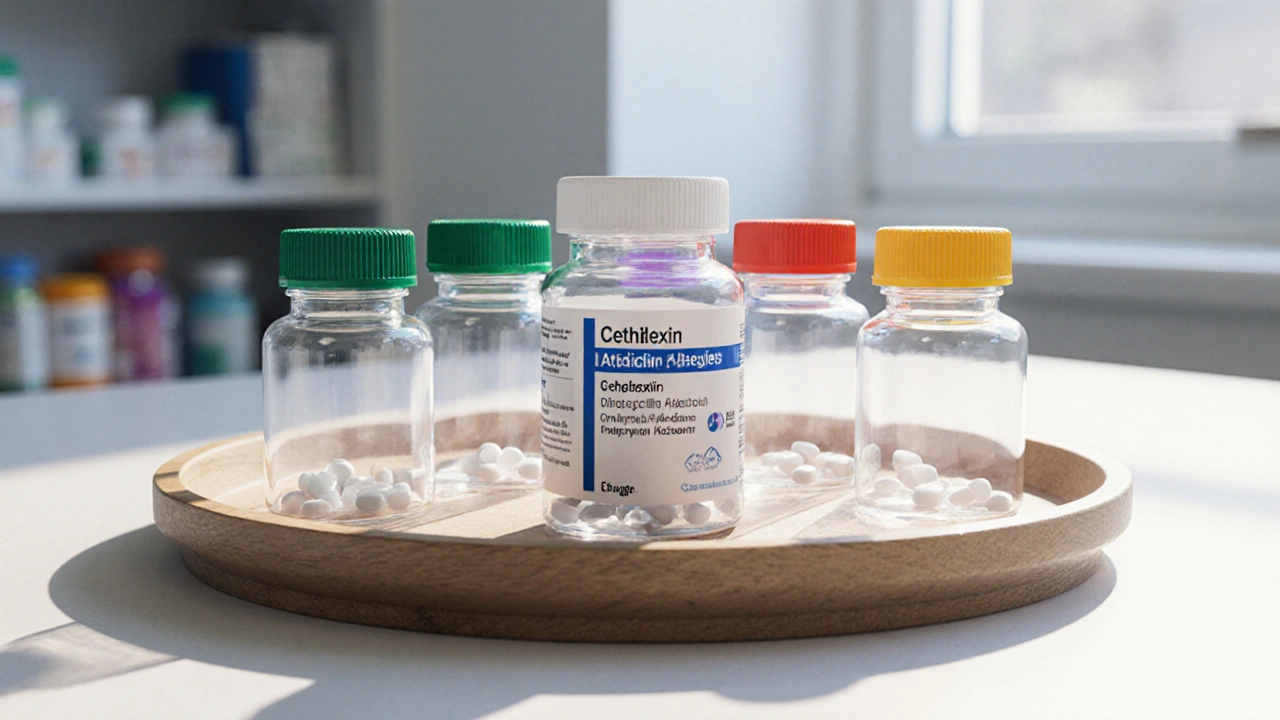Cephalexin (Keftab) vs. Common Antibiotic Alternatives: A Practical Comparison

Cephalexin vs. Antibiotic Alternatives: Quick Comparison Tool
Antibiotic Details
Side Effect Profile
Cost & Availability
Quick Summary
- Cephalexin (brand name Keftab) is a first‑generation cephalosporin best for skin, bone and urinary infections.
- Amoxicillin, dicloxacillin, clindamycin, azithromycin and trimethoprim‑sulfamethoxazole cover overlapping but distinct bacterial spectra.
- Choose based on infection type, allergy history, local resistance patterns and cost.
- All oral antibiotics share common side‑effects like GI upset; each class has unique cautions.
- Consult a pharmacist or physician before switching, especially if you have kidney issues or are pregnant.
When a doctor writes a prescription for a bacterial infection, the first question most patients ask is: "Is this the right drug for me?" In Canada, Cephalexin-sold under the brand name Keftab is a first‑generation cephalosporin antibiotic that targets gram‑positive bacteria and some gram‑negative strains. It’s a solid choice for many skin, bone and urinary infections, but it isn’t a one‑size‑fits‑all solution. This guide breaks down how Cephalexin stacks up against five widely used alternatives, helping you and your prescriber decide what fits your situation best.
What Is Keftab (Cephalexin)?
Cephalexin is a beta‑lactam antibiotic belonging to the cephalosporin class. It works by inhibiting bacterial cell‑wall synthesis, causing the microbe to burst under its own pressure. The drug is available in 250mg and 500mg oral tablets and a liquid suspension for children.
Typical adult dosage ranges from 250mg every 6hours for mild infections to 1g every 6hours for more serious cases. In patients with reduced kidney function, the dose must be adjusted to avoid accumulation.
How Cephalexin Works Compared to Other Classes
Cephalexin’s beta‑lactam ring is structurally similar to penicillins, giving it a comparable safety profile but a broader range against certain gram‑positive organisms like Staphylococcus aureus (non‑MRSA) and Streptococcus pyogenes. Unlike macrolides (e.g., azithromycin) that block protein synthesis, Cephalexin directly tears down the bacterial wall-making it less likely to cause drug‑interaction headaches with drugs metabolized by CYP enzymes.
When to Prefer Cephalexin Over Alternatives
Clinical guidelines (e.g., the Infectious Diseases Society of America) recommend Cephalexin for uncomplicated skin and soft‑tissue infections (SSTIs), uncomplicated urinary tract infections (UTIs) caused by susceptible strains, and osteomyelitis when the organism is known to be cefalosporin‑sensitive. If the patient has a documented penicillin allergy but tolerates cephalosporins, Cephalexin often remains safe because cross‑reactivity is below 5% for first‑generation agents.

Common Alternatives and Their Sweet Spots
Below is a quick snapshot of five antibiotics you’ll often hear mentioned alongside Cephalexin.
- Amoxicillin is a broad‑spectrum penicillin effective against many gram‑positive and some gram‑negative bacteria.
- Dicloxacillin is a penicillinase‑resistant penicillin used primarily for beta‑lactamase‑producing staphylococci.
- Clindamycin is a lincosamide that excels against anaerobes and MRSA‑susceptible strains.
- Azithromycin is a macrolide antibiotic prized for its long half‑life and good tissue penetration.
- Trimethoprim‑sulfamethoxazole (TMP‑SMX) is a sulfonamide combination effective against a range of urinary and respiratory pathogens.
Side‑Effect Profiles at a Glance
All oral antibiotics can cause nausea, diarrhea, and occasional rash. However, each class has signature concerns:
- Cephalexin: mild GI upset; rare allergic reactions; caution in renal impairment.
- Amoxicillin: higher rate of rash in patients with viral infections; possible hepatic enzyme elevation.
- Dicloxacillin: can lead to hepatic toxicity (especially with high doses) and neutropenia.
- Clindamycin: notorious for causing Clostridioides difficile colitis; watch for severe diarrhea.
- Azithromycin: QT‑prolongation risk; interacts with drugs metabolized by CYP3A4.
- TMP‑SMX: may trigger hyperkalemia, especially in patients on ACE inhibitors; avoid in pregnancy first trimester.
Comparison Table
| Antibiotic | Spectrum (major targets) | Typical Uses | Common Side Effects | Resistance Concerns | Approx. Cost (CAD) |
|---|---|---|---|---|---|
| Cephalexin (Keftab) | Gram‑positive, some gram‑negative | Skin, bone, uncomplicated UTIs | Diarrhea, nausea, rash | Low for MSSA; beta‑lactamase producers | $12‑$20 for 30 tablets |
| Amoxicillin | Broad gram‑positive & gram‑negative | Otitis media, sinusitis, dental infections | Rash, GI upset | High in beta‑lactamase producers | $8‑$15 for 30 capsules |
| Dicloxacillin | Penicillin‑resistant staph | SSTIs, cellulitis, bullous impetigo | Hepatotoxicity, neutropenia | Low unless beta‑lactamase high | $15‑$25 for 30 capsules |
| Clindamycin | Anaerobes, MRSA‑susceptible | Deep tissue infections, dental abscess | C.difficile colitis, metallic taste | Rare resistance, but C.difficile risk high | $20‑$35 for 30 tablets |
| Azithromycin | Atypical pathogens, some gram‑positives | Respiratory infections, chlamydia | Diarrhea, QT prolongation | Increasing macrolide resistance | $18‑$30 for 5‑day pack |
| TMP‑SMX | UTI pathogens, some gram‑negatives | UTIs, Pneumocystis jirovecii prophylaxis | Rash, hyperkalemia, photosensitivity | Resistance rising in E.coli | $10‑$18 for 30 tablets |
Decision‑Making Checklist
Before you or your prescriber settle on a drug, run through this quick list:
- Identify the pathogen (if known) and its susceptibility pattern.
- Check for any drug allergies-especially penicillin or macrolide sensitivities.
- Consider patient‑specific factors: kidney function, pregnancy status, age, and concurrent meds.
- Review local resistance data (many health units publish annual antibiograms).
- Factor in cost and insurance coverage-some drugs may be on formularies while others need prior approval.
- Discuss dosing convenience; a once‑daily azithromycin may improve adherence compared to four‑times‑daily Cephalexin.

Cost and Accessibility in Canada (2025)
Generic Cephalexin tablets typically cost $0.40-$0.65 each at major Canadian pharmacies. Amoxicillin is a bit cheaper, while clindamycin and azithromycin sit at a higher price point, especially the branded versions. Many provincial drug plans cover Cephalexin and amoxicillin without extra co‑pay, but clindamycin often requires a special authorization. If you’re using an online pharmacy, compare the total price (including shipping) before ordering.
Safe Use Tips
- Finish the full course even if symptoms improve; stopping early fuels resistance.
- Take Cephalexin with a full glass of water; food can delay absorption but doesn’t reduce effectiveness.
- Stay hydrated to help kidneys flush out the drug, especially if you have reduced renal function.
- Report any severe rash, difficulty breathing, or persistent diarrhea to a health professional immediately.
- If you miss a dose, take it as soon as you remember unless it’s almost time for the next dose-don’t double up.
Frequently Asked Questions
Frequently Asked Questions
Can I take Cephalexin if I’m allergic to penicillin?
Yes, most people with a true penicillin allergy can tolerate first‑generation cephalosporins like Cephalexin because cross‑reactivity is under 5%. However, always tell your doctor about the exact reaction you experienced.
How long does it take for Cephalexin to start working?
Symptoms often improve within 48-72hours, but you should complete the full prescribed course, which is usually 7-10days for skin infections.
Is it safe to use Cephalexin during pregnancy?
Cephalexin is classified as Pregnancy Category B in Canada, meaning animal studies showed no risk and there are no well‑controlled studies in pregnant women. Doctors often prescribe it when the benefits outweigh any theoretical risk.
What should I do if I develop diarrhea while on Cephalexin?
Mild diarrhea is common and usually resolves. If you notice watery stools, abdominal cramping, or fever-signs of C.difficile infection-stop the drug and contact a health professional right away.
Can I switch from Cephalexin to amoxicillin if my infection isn’t improving?
Only after a clinician assesses culture results or clinical response. Switching without guidance may worsen resistance or miss the appropriate target.






Drew Chislett
October 5, 2025 AT 19:05Finishing the full course of Cephalexin, even when you start feeling better, is the best way to make sure the infection is truly gone. It also helps keep resistance down, which benefits everyone down the line. If you have kidney concerns, the doctor can tweak the dosage without cutting the treatment short. Keep hydrated and take it with a full glass of water for smoother absorption.
Rosalee Lance
October 9, 2025 AT 11:53Big pharma loves to push brand names like Keftab, but the real story is that many cheap generics work just as well. Don't let marketing hype dictate your prescription; ask for the plain molecule name, Cephalexin, and watch the cost drop. Remember, every unnecessary profit margin fuels the cycle of over‑prescribing and hidden data collection. Staying informed is a quiet act of rebellion against the hidden agenda.
Kara Lippa
October 15, 2025 AT 06:46Cephalexin’s side‑effect profile is pretty mild, mostly limited to gastrointestinal upset. If you notice a rash, it’s usually harmless but worth mentioning to your clinician. The drug’s renal dosing guidelines are clear, so patients with reduced kidney function can stay safe. Overall, it’s a solid choice for skin and uncomplicated urinary infections.
Puneet Kumar
October 21, 2025 AT 01:40When selecting an oral antibacterial for a community‑acquired infection, it is essential to align the pharmacodynamic targets with the pathogen’s minimum inhibitory concentration (MIC). Cephalexin, as a first‑generation cephalosporin, achieves time‑dependent killing, meaning that maintaining plasma concentrations above the MIC for a substantial portion of the dosing interval is critical. In skin and soft‑tissue infections, the drug’s high bioavailability (approximately 90%) ensures that standard dosing regimens reach therapeutic levels in the interstitial fluid where Staphylococcus aureus typically resides.
For urinary tract infections, the drug’s renal excretion provides high urinary concentrations, but clinicians must assess creatinine clearance to avoid accumulation in patients with compromised glomerular filtration. Adjustments to the 250‑500 mg dosing frequency are recommended when the estimated creatinine clearance falls below 30 mL/min.
Comparatively, amoxicillin’s broader spectrum comes at the cost of heightened beta‑lactamase susceptibility, which can be mitigated by pairing with clavulanic acid in resistant settings. Dicloxacillin offers a penicillinase‑resistant option, yet its hepatic metabolism introduces a different safety profile that demands liver function monitoring.
Clindamycin’s anaerobic coverage is valuable for deep‑seeded infections, but the risk of Clostridioides difficile colitis makes it a second‑line agent unless MRSA coverage is explicitly required. Azithromycin’s long half‑life facilitates once‑daily dosing, yet its QT‑prolongation potential and drug‑drug interaction via CYP3A4 necessitate a careful cardiovascular assessment.
Trimethoprim‑sulfamethoxazole remains a staple for uncomplicated UTIs, but rising E. coli resistance and the possibility of hyperkalemia in ACE‑inhibitor users warrant vigilant electrolyte monitoring.
From a health‑economics standpoint, generic Cephalexin often lands in the low‑cost tier, especially within Canadian provincial formularies, making it an accessible first‑line agent for many patients. In contrast, clindamycin and azithromycin can incur higher out‑of‑pocket expenses, potentially limiting adherence.
Ultimately, the decision matrix should incorporate pathogen susceptibility data (ideally guided by local antibiograms), patient comorbidities such as renal or hepatic impairment, drug interaction potential, and socioeconomic considerations like insurance coverage and medication cost. By systematically evaluating these variables, clinicians can tailor antibiotic therapy to maximize efficacy while minimizing adverse events and resistance pressure.
michael maynard
October 26, 2025 AT 20:33The cost disparity between cheap generics and brand‑name antibiotics is no accident; it’s a deliberate push to keep us hooked on higher‑priced prescriptions. You’ll see the same molecule in a $10 bottle and a $30 one, yet the pharma lobby frames the expensive version as "premium". It’s a classic distraction that keeps the profit wheels turning while the real problem-overprescribing-gets buried under marketing fluff.
Roger Bernat Escolà
November 1, 2025 AT 15:26Be aware that Cephalexin can cause mild diarrhea, but severe watery stools could signal C. difficile and need urgent medical attention.
Sumit(Sirin) Vadaviya
November 7, 2025 AT 10:20Cephalexin remains a cost‑effective choice for many infections, and its safety profile is well‑documented 😊. Patients with mild renal impairment should discuss dose adjustments with their prescriber to maintain therapeutic levels without excess accumulation.
lindsey tran
November 13, 2025 AT 05:13hey guys, just wanted 2 say if u pick cephalexin, make sure u finish the whole script – it really helps keep the bug from comin back. also, stay hydrated, it helps the med work better.
Courage Nguluvhe
November 19, 2025 AT 00:06Your point about monitoring renal function is spot‑on; dosage adjustments based on creatinine clearance prevent sub‑therapeutic exposure while safeguarding against toxicity. Additionally, referencing local antibiograms can refine empirical choices, ensuring the selected agent aligns with prevailing susceptibility patterns.
Oliver Bishop
November 24, 2025 AT 19:00American‑made antibiotics are the gold standard.